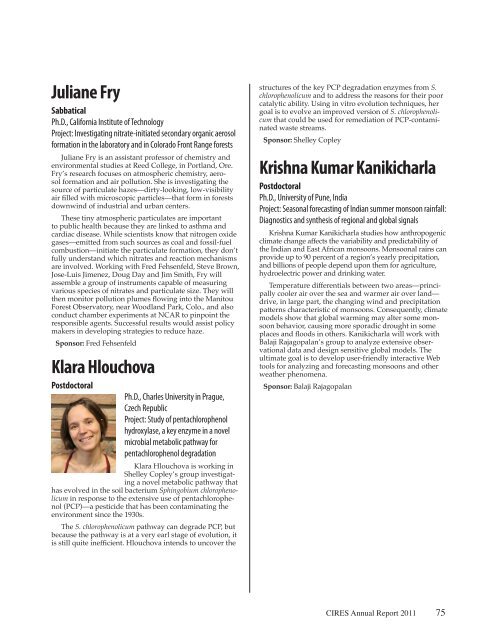2011 - Cooperative Institute for Research in Environmental Sciences ...
2011 - Cooperative Institute for Research in Environmental Sciences ...
2011 - Cooperative Institute for Research in Environmental Sciences ...
Create successful ePaper yourself
Turn your PDF publications into a flip-book with our unique Google optimized e-Paper software.
Juliane Fry<br />
Sabbatical<br />
Ph.D., Cali<strong>for</strong>nia <strong>Institute</strong> of Technology<br />
Project: Investigat<strong>in</strong>g nitrate-<strong>in</strong>itiated secondary organic aerosol<br />
<strong>for</strong>mation <strong>in</strong> the laboratory and <strong>in</strong> Colorado Front Range <strong>for</strong>ests<br />
Juliane Fry is an assistant professor of chemistry and<br />
environmental studies at Reed College, <strong>in</strong> Portland, Ore.<br />
Fry’s research focuses on atmospheric chemistry, aerosol<br />
<strong>for</strong>mation and air pollution. She is <strong>in</strong>vestigat<strong>in</strong>g the<br />
source of particulate hazes—dirty-look<strong>in</strong>g, low-visibility<br />
air filled with microscopic particles—that <strong>for</strong>m <strong>in</strong> <strong>for</strong>ests<br />
downw<strong>in</strong>d of <strong>in</strong>dustrial and urban centers.<br />
These t<strong>in</strong>y atmospheric particulates are important<br />
to public health because they are l<strong>in</strong>ked to asthma and<br />
cardiac disease. While scientists know that nitrogen oxide<br />
gases—emitted from such sources as coal and fossil-fuel<br />
combustion—<strong>in</strong>itiate the particulate <strong>for</strong>mation, they don’t<br />
fully understand which nitrates and reaction mechanisms<br />
are <strong>in</strong>volved. Work<strong>in</strong>g with Fred Fehsenfeld, Steve Brown,<br />
Jose-Luis Jimenez, Doug Day and Jim Smith, Fry will<br />
assemble a group of <strong>in</strong>struments capable of measur<strong>in</strong>g<br />
various species of nitrates and particulate size. They will<br />
then monitor pollution plumes flow<strong>in</strong>g <strong>in</strong>to the Manitou<br />
Forest Observatory, near Woodland Park, Colo., and also<br />
conduct chamber experiments at NCAR to p<strong>in</strong>po<strong>in</strong>t the<br />
responsible agents. Successful results would assist policy<br />
makers <strong>in</strong> develop<strong>in</strong>g strategies to reduce haze.<br />
Sponsor: Fred Fehsenfeld<br />
Klara Hlouchova<br />
Postdoctoral<br />
Ph.D., Charles University <strong>in</strong> Prague,<br />
Czech Republic<br />
Project: Study of pentachlorophenol<br />
hydroxylase, a key enzyme <strong>in</strong> a novel<br />
microbial metabolic pathway <strong>for</strong><br />
pentachlorophenol degradation<br />
Klara Hlouchova is work<strong>in</strong>g <strong>in</strong><br />
Shelley Copley’s group <strong>in</strong>vestigat<strong>in</strong>g<br />
a novel metabolic pathway that<br />
has evolved <strong>in</strong> the soil bacterium Sph<strong>in</strong>gobium chlorophenolicum<br />
<strong>in</strong> response to the extensive use of pentachlorophenol<br />
(PCP)—a pesticide that has been contam<strong>in</strong>at<strong>in</strong>g the<br />
environment s<strong>in</strong>ce the 1930s.<br />
The S. chlorophenolicum pathway can degrade PCP, but<br />
because the pathway is at a very earl stage of evolution, it<br />
is still quite <strong>in</strong>efficient. Hlouchova <strong>in</strong>tends to uncover the<br />
structures of the key PCP degradation enzymes from S.<br />
chlorophenolicum and to address the reasons <strong>for</strong> their poor<br />
catalytic ability. Us<strong>in</strong>g <strong>in</strong> vitro evolution techniques, her<br />
goal is to evolve an improved version of S. chlorophenolicum<br />
that could be used <strong>for</strong> remediation of PCP-contam<strong>in</strong>ated<br />
waste streams.<br />
Sponsor: Shelley Copley<br />
Krishna Kumar Kanikicharla<br />
Postdoctoral<br />
Ph.D., University of Pune, India<br />
Project: Seasonal <strong>for</strong>ecast<strong>in</strong>g of Indian summer monsoon ra<strong>in</strong>fall:<br />
Diagnostics and synthesis of regional and global signals<br />
Krishna Kumar Kanikicharla studies how anthropogenic<br />
climate change affects the variability and predictability of<br />
the Indian and East African monsoons. Monsoonal ra<strong>in</strong>s can<br />
provide up to 90 percent of a region’s yearly precipitation,<br />
and billions of people depend upon them <strong>for</strong> agriculture,<br />
hydroelectric power and dr<strong>in</strong>k<strong>in</strong>g water.<br />
Temperature differentials between two areas—pr<strong>in</strong>cipally<br />
cooler air over the sea and warmer air over land—<br />
drive, <strong>in</strong> large part, the chang<strong>in</strong>g w<strong>in</strong>d and precipitation<br />
patterns characteristic of monsoons. Consequently, climate<br />
models show that global warm<strong>in</strong>g may alter some monsoon<br />
behavior, caus<strong>in</strong>g more sporadic drought <strong>in</strong> some<br />
places and floods <strong>in</strong> others. Kanikicharla will work with<br />
Balaji Rajagopalan’s group to analyze extensive observational<br />
data and design sensitive global models. The<br />
ultimate goal is to develop user-friendly <strong>in</strong>teractive Web<br />
tools <strong>for</strong> analyz<strong>in</strong>g and <strong>for</strong>ecast<strong>in</strong>g monsoons and other<br />
weather phenomena.<br />
Sponsor: Balaji Rajagopalan<br />
CIRES Annual Report <strong>2011</strong> 75
















